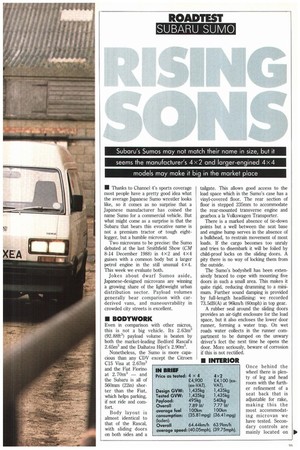• Thanks to Channel 4's sports coverage most people have
Page 35

Page 36

If you've noticed an error in this article please click here to report it so we can fix it.
a pretty good idea what the average Japanese Sumo wrestler looks Like, so it comes as no surprise that a Japanese manufacturer has coined the name Sumo for a commercial vehicle. But what might come as a surprise is that the Subaru that bears this evocative name is not a premium tractor or tough eightlegger, but a humble microvan.
Two microvans to be precise: the Sumo debuted at the last Smithfield Show (CM 8-14 December 1988) in 4x2 and 4X4 guises with a common body but a larger petrol engine in the still unusual 4X4. This week we evaluate both.
Jokes about dwarf Sumos aside, Japanese-designed microvans are winning a growing share of the lightweight urban distribution sector. Payload volumes generally bear comparison with carderived vans, and maneouvrability in crowded city streets is excellent.
Even in comparison with other micros, this is not a big vehicle. Its 2.63m3 (92.881t3) payload volume is beaten by both the market-leading Bedford Rascal's 2.65m3 and the Daihatsu Hijet's 2.90m3.
Body layout is almost identical to that of the Rascal, with sliding doors on both sides and a tailgate. This allows good access to the load space which in the Sumo's case has a vinyl-covered floor. The rear section of floor is stepped 235mm to accommodate the rear-mounted transverse engine and gearbox a la Volkswagen Transporter.
There is a marked absence of tie-down points but a well between the seat base and engine hump serves in the absence of a bulkhead, to restrain movement of most loads. If the cargo becomes too unruly and tries to disembark it will be foiled by child-proof locks on the sliding doors. A pity there is no way of locking them from the outside.
The Sumo's bodyshell has been extensively braced to cope with mounting five doors in such a small area. This makes it quite rigid, reducing drumming to a minimum. Further sound damping is provided by full-length headlining: we recorded 73.5dB(A) at 96km/h (60mph) in top gear.
A rubber seal around the sliding doors provides an air-tight enclosure for the load space, but it also encloses the lower door runner, forming a water trap. On wet roads water collects in the runner compartment to be dumped on the unwary driver's feet the next time he opens the door. More seriously, beware of corrosion if this is not rectified.
Once behind the wheel there is plenty of leg and head room with the further refinement of a seat back that is adjustable for rake, making this the most accommodating microvan we have tested. Secondary controls are mainly located on two steering-column stalks which are the opposite way round to the European stan dard, with the indicators on the right.
None of these instruments are illuminated. Visibility is good but could be improved by larger mirrors and a rear screen wiper.
Only the red button on top of the gear lever to engage four-wheel drive, and a green light to show engagement, diffe rentiate the two vans internally. Pale vinyl trim and door furniture will soon become ingrained with dirt, and while the window winders and door handles work well, they are very small and look vulnerable.
The Sumo's most irritating fault is its heater, which is totally unable to direct warm air to the upper part of the driver's body. If a comfortable cab temperature is to be maintained in cold weather the driver must suffer localised discomfort as his left foot takes the full blast of hot air.
To gain access to the engine for daily checks the rear bumper hinges down.
This is done by releasing a catch underneath the tailgate then lifting the right hand end to release a safety catch. Collected road dirt makes this a messy operation, especially after driving in the wet.
The engine is discovered lying on its side shrouded with exhaust piping. While the oil filler cap is immediately accessible, the dip stick is hidden a long way into the works so checking the oil level can also be a messy operation.
Similar inconvenience awaits anyone checking the coolant level as the radiator cap is at waist height and covered by the tailgate, while the header tank is in the engine compartment on the right hand side. Filling this tank involves unscrewing a wing nut to remove it completely before filling and re-fitting.
When a service is required part of the raised-rear-floor section can be removed to gain greater access to the engine.
The main difference between the engines fitted in the 4x2 and 4x4 Sums is their capacity. The 4x2 is a 997cm3 unit; a different crankshaft gives a longer stroke in the 4x4 version (up from 69.6nun to 83rnm), which in turn pushes the swept volume up to 1,189cm3; a relative giant by microvan standards.
The all-alloy transverse three-cylinder engine certainly benefits from those extra cubes. Torque rises from 81Nm (60Ibft) on the 997cm3 unit to a 'beefy' (sic) 97Nm (71.61bft). Other benefits include a lower compression ratio (down from 9.5 to 9.1:1) and lower peak-power revs (down from 3,200rpm to 2,800rpm), so these changes bode well for the larger engine's service life. Both engines will run on unleaded fuel or soon-to-be-lost two-star.
Five-speed gearboxes come as standard, and the ratios are well-chosen, albeit unusual. In the smaller engine they range from 3,166:1 to 0.685:1 with a final drive ratio of 5.833:1. This allows the use
























































































































